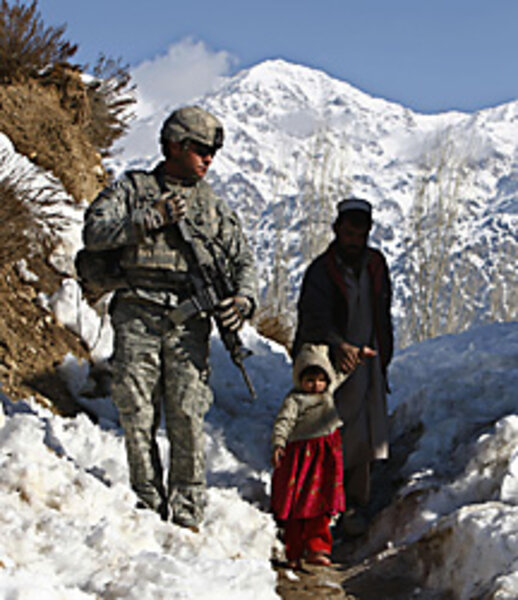New bid to control Pakistan’s tribal belt
Loading...
| Islamabad, Pakistan
After years of Pakistani indecision and US deference, the fight against Pakistan's terrorists, it appears, is now entering a new stage.
Since 9/11, Pakistan has been slow to react to the increasing influence of militants in its remote tribal areas bordering Afghanistan, and the US has been loath to interfere, at least openly.
But this dynamic is shifting since terrorists killed former Prime Minister Benazir Bhutto and are striking at more corners of the country. For the first time, the US is putting public pressure on Pakistan by asking its leaders to let the US help fight terrorists within the country. Though Pakistan has rebuffed these advances, it has shown signs of taking the terrorist threat more seriously, responding quickly and forcefully to militants' increasingly bold attacks.
It is too early to call this a turning point – it is far from clear what effect these efforts will have. But they suggest a new resolve to address what has become the primary launching pad for terrorist attacks against Pakistan, Afghanistan, and the world.
"There is a realization within the military establishment that the government has lost its authority in the tribal areas," says Ismail Khan, a reporter for the English-language daily, Dawn, who covers the tribal belt.
In recent weeks, the US has offered military assistance to root out extremists in the largely ungoverned northwestern regions known as the Federally Administered Tribal Areas (FATA) – with combat troops, CIA operations, or training.
President Pervez Musharraf has rejected the "invasion" of US troops. But the US is becoming increasingly concerned that activity within FATA is now the foremost threat to the stability in the region and even the world.
US officials have long worried that the Afghan Taliban were finding shelter in FATA. But the assassination of former Ms. Bhutto Dec. 27 – attributed to militants from FATA – was evidence that they could strike at the heart of Pakistan itself. Meanwhile, a string of terrorist plots, including the foiled plan to blow up passenger planes over the Atlantic, were traced to training camps and terrorist leaders in FATA.
As a result, there is a desire to increase coordination on both sides of the Afghan-Pakistan border. Tactically, "Pakistan and Afghanistan are not different," says Ijaz Khan, a political scientist at Peshawar University. "They should be seen together."
With plans to send 3,200 more troops to Afghanistan in the spring, the US is adding strength to the Afghan side. America's overtures to Pakistan represent an effort to "find ways to strengthen the Pakistan Army," says Anthony Cordesman, a security analyst at the Center for Strategic and International Studies in Washington.
He dismisses unilateral US action in Pakistan as implausible and counterproductive unless it is small, strictly targeted, and can be plausibly denied – the sort of operation Pakistan might secretly accept.
Already, the US is believed to launch periodic missiles into Pakistan from drone aircraft flying from Afghanistan. A Jan. 29 strike in North Waziristan was said by locals to have been one of these. The Pakistani government has also launched airstrikes in the region, but the US and Pakistan deny responsibility for such attacks, which have occurred periodically in recent years.
For its part, Pakistan has shown signs of dealing with its militants more decisively. Last week, militants in FATA hijacked four trucks filled with military materiel. In the past, militants have occupied a mosque in the capital, Islamabad, for months without a response from the military. But days after the hijacking, the Army sent tanks and troops to a nearby town where Taliban had walked the streets freely.
Earlier this month, Mr. Musharraf replaced the regional governor who oversees security in FATA. The previous governor, Ali Jan Aurakzai, engineered the withdrawal of the Pakistani Army from FATA in 2006 in exchange for a promise from local tribal leaders that they would expel any foreign militants. The plan is now widely viewed as a failure that greatly strengthened militants. The new governor, Owais Ahmad Ghazi, gained his reputation by putting down an insurgency in the neighboring province of Balochistan by force.
Many Pakistani analysts, however, doubt Pakistan's commitment rto stamping out militancy. They question whether it is merely going through these motions to ease international pressure, as they say it has before.
To some, the Army is still reluctant to turn against these extremists, whom it used before 9/11 to terrorize India and establish, through the Taliban, a pro-Pakistan government in Afghanistan. If it will not change this mind set, the current operations will fail, they say.
What is needed, they say, is for the US to use the same sophistication that it did in Iraq, where Marines in Anbar Province used their knowledge of the cultural landscape to fight a more nuanced and effective war.
In FATA, America cannot do the fighting, but it can use its influence to ensure that Pakistan fights more intelligently, says Ikram Sehgal, editor of Defence Journal. "The US needs to apply pressure, but it needs to apply the right kind of pressure."
The solution, he says, is not intensified operations, which are likely to alienate the fiercely independent tribal belt. Instead, the Army should use tribal chiefs to leverage the situation in their favor, supporting those who oppose the militants.
In an area such as FATA, intersecting allegiances of tribe and ethnicity create a patchwork of problems that can vary from one village to the next.
"You have to get into the micro-level to find what the problems are in each area and find the solutions to that," says Mr. Khan, the journalist.





